
Boys and Girls, we’ve had a most amazing field trip to visit to the highest spires of the Temple of the Rock God and Filmmakers’ Nirvana. We had the honour of sitting with Director Martin Scorsese as he pondered the mythos and conundrums of capturing his newest epic, Shine a Light. Mr. Scorsese is joined by a little-known blues band from London.
Ladies and gentlemen, The Rolling Stones.
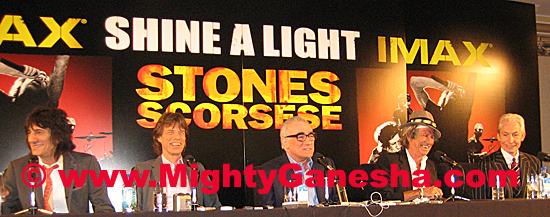
Mick Jagger: Good afternoon, everyone. Good afternoon, New York!
Q: Why was it important to film in a small venue (- the Beacon Theatre)? Was there any special connection to the audience at this show?
Martin Scorsese: The importance of making the film in a small venue for me, we discussed doing it in a bigger arena and I looked into that. And actually while I was doing it, while I was trying to prepare for that, I realised that I’m better suited to try to capture the group onstage in a smaller stage, more for the intimacy of the group and the way they play together. The way you see the band work together and work each song, I find that to be interesting and it’s a compulsion of mine. I love to be able to see that and have that be able to cut from one image to the other - movement and that sort of thing, but really about the intimacy of the group and how they work together.
Q: Mick?
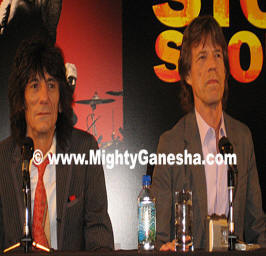 Mick
Jagger: Well, I can’t
remember what you said now, but the audience was a good audience because
I think they really got into the spirit of making the movie as well as
enjoying the being an audience for the band. They were a great audience
for the band.
Mick
Jagger: Well, I can’t
remember what you said now, but the audience was a good audience because
I think they really got into the spirit of making the movie as well as
enjoying the being an audience for the band. They were a great audience
for the band.
Keith Richards: They were all cameramen. {Laughs}
MS: {Laughs} They enjoyed it. The cameramen liked it.
Q: Keith, anything special about that night?
KR: The Beacon Theatre is special anyway for some reason, anyway. It wraps its arms around you. Especially if you can play there for more than one night and you start to get… The room sort of wraps its arms around you and every night gets like, warmer. It’s a great feeling room, y’know. Also, hey, this band didn’t start off in stadiums {Laughs}
Q: Charlie, do you want to comment?
Charlie Watts: No.
{All laugh}
Ron Wood: I knew he'd say that.
Q: How is the experience of seeing the film in IMAX going to be different for the fans?
MJ: It’ll be very larger. {All laugh} The slight imperfections might be revealed. The funny thing is though really is that Marty, after looking at all the options decided he wanted to make this small, intimate movie, and I said, “Well the laugh is though, Marty, that in the end it’s going to be blown up to this huge, IMAX thing, so the intimate moment is shown in IMAX. But it looks good in IMAX, so we got both formats, so we’re happy about that.
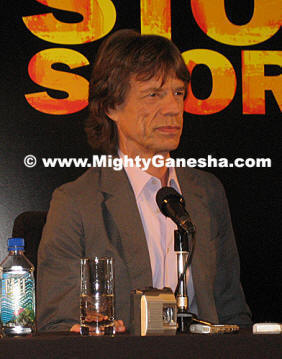 Q:
Shine a Light reminds of us the boundless energy of the band. Starting
with Mr. Jagger, we’d like to know what vitamins you’re taking and what’s
your workout like?
Q:
Shine a Light reminds of us the boundless energy of the band. Starting
with Mr. Jagger, we’d like to know what vitamins you’re taking and what’s
your workout like?
MJ: Oh God… forget all that.
KR: You’ll all be on it {Laughs}
MJ: No gym, no vitamins, I think that day, just do it, just get there. Y’know, you get very pressurised in these situations, though. The thing is, I always find when there’s a movie shoot you have to really come up to the plate and we fortunately had two nights of this. When Keith was saying it’s good to play there more than one night and I agree with him, cos the first night we played was more like a rehearsal for us in a way, and by the time the second night came round, we got more adjusted to playing in the small theatre because though we’d played lots of small theatres in the past, we hadn’t done any on this tour, so this is like quite different suddenly to go into this small theatre. So, by the second night we sort of knew how to do it, this was going to be the night where there were all these people there and everything, so I felt really good about that particular night so you know, sometimes you have to come and do it.
KR: It was a turn on.
MJ: Yeaaahhhh….
Q: Why did you choose Marty to direct the film?
MJ: He’s the best one around!
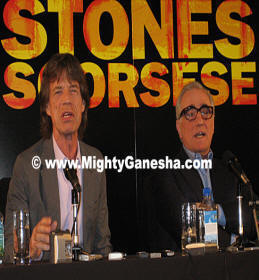 Q:
But what would he do that other directors wouldn't?
Q:
But what would he do that other directors wouldn't?
MJ: Aw, I can’t, I can’t answer that. I’m gonna embarrass him now. He’s not part of the furniture, he’s actually sitting here. He’s a fantastic director and he assembled a wonderful crew, I think that he can agree with that. He got fantastic DP’s camera, lighting, everyone working on it, and then very painstaking on the editing to produce the movie that you see. It’s not all in the shooting it’s obviously in the editing, too.
Q: Mr. Scorsese, having made so many films about the mafia and the underworld, how does that compare to working with the Rolling Stones?
MS: (Laughs) Uh, well, now, that’s an interesting question. I don’t think I make direct associations to it, but the music is something that deals with… It reminds me, I tell ya, it reminds me of when I went to see Threepenny Opera back in 1959, 1960 at the Theatre De Lys, and how the music affected me and what that was saying, what play said, the lyrics were so important to me in that particular play. And I grew up in an area that was kind of in a sense like the Threepenny Opera, and I think at times, their music, the Rolling Stone had a similar effect on me or it dealt with aspects of the life that I was growing up around me that I was associated with or saw or was experiencing and trying to make sense of. And so, it was tougher, had an edge, beautiful and honest and brutal at times. and powerful, and it’s always stayed with me and it’s become a well of inspiration to this day. As Mick said in Berlin, he said – may I take the line from you?
MJ: Yeah, yeah.
MS: “I want you to know that this only film, Shine a Light is the only film in which “Gimme Shelter” is not played in.” I mean I used “Gimme Shelter” in a film, which I think is just as apropos of the world we’re living in today, “Gimme Shelter”, when I used it in a film I don’t remember that I used it before. I say, “Oh, let’s use that,” and they say, “Marty, you did that before,’ and I say “Oh it’s all right, let’s put it in.” I keep forgetting, but it’s something that their music has been very important for me over these years.
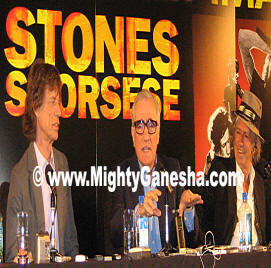 Q:
For Mick and Keith, which of Martin’s films are you favourites?
Q:
For Mick and Keith, which of Martin’s films are you favourites?
MJ: Which one do you like Keith? Marty’s favourite.
KR: Oh, me?
MJ: Which one is your favourite?
KR: What, I’m supposed to know what’s Marty’s favourite?
MJ: No, no, no… Kundun’s my favourite!
{Laughter}
MJ: That’s not a joke.
{Laughter}
MJ: You did do that one?
MS: I did do it, yes, I did.
MJ: I like all of them, I love all of his. It’s hard to choose your favourite, but …
KR: They’re our babies.
MJ: I love nearly all of Marty’s and I can’t wait for the next one.
Q: Martin, in The Departed, you used “Let it Loose”, which is a more obscure song from Exile on Main Street, why did you choose that song for that film?
MS: “Let it Loose” I think is from Exiled, isn’t it?
MJ: Yeah
KR: Yes.
MS: “Let it Loose” is from Exiled on Main Street, an album I like a lot. And that again is sort of in my DNA, so to speak, the music. So, it just came the way Jack Nicholson sat down next to Leonardo Di Caprio and said, “Do you know who I am?” The tone of that and the mood, I heard that sound from that song and I played it again. So, I tried a couple of other things afterwards, cos invariably you say, ‘Well, that’s the first one, it can’t be. It works, but it can’t be. Working on the first try, it can’t be that way.” So we tried some other songs, but we went back to “Let it Loose,” and placed it just at the right moments in between the dialog for the highlights of the song. But it had the tone and mood and again the edge I thought that the scene and that the characters were like, really.
Q: Can you tell us about the choice of songs for the setlist?
MJ: Hmm, I don’t really know now, it’s like 18 months ago… {Laughs}
KR: Michael, he comes up with the set list because got to sing them. And unless I say suddenly, ‘Hey Mick, you’ve got 10 songs in the same key,’ I don’t interfere. So, we make it up, the man’s got to sing ‘em.
MJ: I think you pick the one you think is best for the night, really.
KR: There might be a sore throat ….
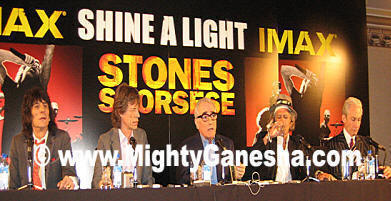 Q:
How much fun are you guys still having doing this all these years later?
And Martin, what moments of affection did you want to capture?
Q:
How much fun are you guys still having doing this all these years later?
And Martin, what moments of affection did you want to capture?
MJ: Oh, I’m having a lot of fun. It took us two days to shoot the picture; we’ve spent about four days doing the premieres and promotions. Its like taken twice as long doing that, but I think that we had a lot of fun. Y’know, shooting this movie was quite nerve-wracking in some ways. It was fantastically enjoyable, but in other ways, you know, as I said before, it’s very nerve-wracking for us, because we know we have to do something on the night. And I’m sure Marty got a lot of things going on, he’s got to cover it if it happens. So, you know, it was quite a challenge and you know to talk about “having fun”? Yeah, it was great fun to do but it was quite a challenge for everyone on this platform to come up with the goods both on the night and after it. So you know you see this careerwise, you always see these things as great fun, but they’re also challenges to do these things that are slightly different from what you do normally.
MS: For me, it was literally the moments where you can see the band actually working together. Each song like a narrative, its own narrative, a dramatic story, And the whole sound of the band is like a character, y’know one character in each song. And so with the grace of these wonderful cinematographers, headed by Bob Richardson, people like Bob Elswit and Ellen Kuras and Tasz and Chivo and John Toll and Lesnie, who did Lord of the Rings, Andrew Rowlands. They were like poets at times able to know exactly when to move that camera and pick up another member of the band. And when a camera went down, remember we shot this in 35 millimeter, not video, so that we had 10-minute loads, we were going down all the time; cameras were running out of film. Another camera would pick up where someone left off and that’s why there were so many, to be able to pick up the slack. The key was to find the moments between the members of the band. How they play together, how they work together. And how they worked it like a machine, its own entity in a way.
KR: It’s almost Swiss.
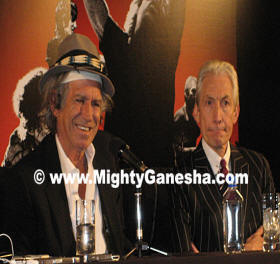 Q:
Who chose the archival footage we see in the film? And in the film the
Stones say they can still see themselves playing when they’re 60, do you
think you’ll still be doing this when you’re 70?
Q:
Who chose the archival footage we see in the film? And in the film the
Stones say they can still see themselves playing when they’re 60, do you
think you’ll still be doing this when you’re 70?
KR: That’s 5 years away! {Laughs}
Ron Wood: It’s close.
KR: Not that far, not far, whoo!
MS: Who chose the clips? David Tedeschi’s the editor of the film and we worked together for almost nine or ten months. The music came together rather quickly, I think, in the cutting and that was very enjoyable. The hardest part was putting together the clips. I think there was over 400 hours of footage that he sort of culled for the documentary sections of archival footage. Then he chose about 40 hours for me to see. And then we worked from that 40 hours and it was matter of balancing, of saying something, but not saying something and then saying nothing with it, that was the key. And balancing it so it wouldn’t unbalance the music and the piece, because to do a film with all archival footage would be a four or five hour documentary.
Q: Mick, what did you think when you watched the archival footage?
MJ: There were some moments when the archival footage I felt was going too long. And I felt we were going off into another movie and we’re forgetting we’re in a concert. Cos it was very kind of riveting sometimes the old movies, but if it goes on sometimes too long, you wanna come back to the concert stage. So sometimes David left them a little bit on the long side, so in the end we ended up with what we had which was good.
Q: Do you plan to do an acoustic album or something closer to Beggar’s Banquet?
MJ: It wasn’t really an acoustic album; it did have acoustic guitars on it, I’m sure. We don’t actually have a plan to do an acoustic album.
RW: You mean like Unplugged?
MS: We have some acoustic on the featurette.
MJ: Yeah, we do have some acoustic songs in the featurette on the DVD.
KR: When ya can’t afford the electricity, baby …
MJ: Yeah, that’s right now.
Q: With reference to the use of Just My Imagination, do you plan to make a tribute album to someone or towards something like Motown?
MJ: I often do tribute to Martha and the Vandellas in front of my mirror.
Q: Can you talk about your relationship with Buddy Guy and working with the other artists in the film?
MJ: Well, Buddy Guy we’ve done quite a few shows with Buddy Guy in past, I think we’ve known him on and off for quite a long time. He’s like one of those continuing wonderful blues performers that you admire.
KR: I met him through Muddy Waters, y'know, it goes back a long way.
MJ: Yeah. And you know I think the thing that Marty captured, the duet thing that we did with him was really one of the high points of the movie for me.
KR: I didn’t give him that for nothing, man.
MJ: That wasn’t just for show! {Laughs}
KR: I know. That’s a bloody high point for me on that.
MJ: And the other guests are really, all in their slightly different ways, all sort of add to the movie, y'know? And I like all of the duets very much, I think they really all work. Cos they don’t always work those duets! {Laughs}
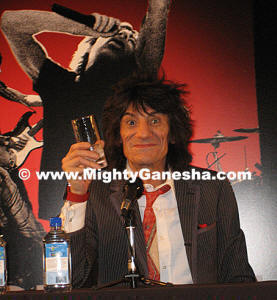 RW:
And Christina’s very soulful.
RW:
And Christina’s very soulful.
MJ: I think that everyone sort of likes all the duets and they really come off, so thanks.
Q: How much of a reference was the work of Albert Maysles and the earlier films about the Stones?
MS: Al’s sort of the reference, the line, the continuity of films a number of wonderful films going back of course, Gimme Shelter, Hal Ashby’s, Let’s Spend the Night Together, and the Godard film …
KR: Let’s not forget Cocksucker Blues.
MS: Cocksucker Blues. But also the Godard film where you actually see the song, “Sympathy for the Devil” come together in the recording studio, which is fascinating. So this is a direct reference to the past films.
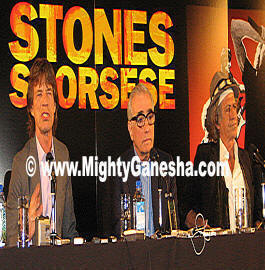 Q:
Marty, those scenes in the film where you’re waiting for the set list to
arrive – how real was the tension in those sequences?
Q:
Marty, those scenes in the film where you’re waiting for the set list to
arrive – how real was the tension in those sequences?
MJ: Totally real, I can tell you!
MS: I trimmed it a bit; I mean the actual phone call was 45 minutes, so I cheated a bit. Over 45 minutes. But you know the idea is to capture the spontaneity of the group and the word capture means you have to control somewhere, but you can’t control the spontaneity. Therefore, the cameras have gotta be in the right position. Then I wanted to go a little further and that is have them all moving cameras, but that means they could collide with the performance so you have to be very careful and all this sort of thing. And also the band is on tour. So, basically we all were kind of talking to each other like little talking boxes, let just get that shot. I shot I think at 11:00 on video I sent my assistant over to the hotel next door, they had white phone “Get me a white phone,” cos it happened on a white phone. We put it right into the machine, David, and I, “Just get the voice, the little box there, the speaker,” like Zeus, the voice of Zeus coming out of the air. The humour of that was that we could never even be in the same city together for a long period of time, and so we had to work that way. And I did trim down the phone call, that’s true, I trimmed it down, although me talking about a camera movement, I couldn’t stop talking about in cameraman moves and swoops, that’s real, that’s very real. And the set list itself, I mean had to really be something they all worked out almost I think to the last minute. I mean you have to, as he {Mick} says know the room, you gotta feel the temperature of the audience, gotta feel what’s happening. As he {Keith} it could be a sore throat, it could be anything. And so, I was concerned that we got as much as we could on film because the film was running out of the magazines at 10 minutes a clip. So, I wanted to get the first three songs completely with all 12 or 15 cameras, whatever it was. But inevitably, some of them are gonna go out, which happened I think with She Was Hot, but luckily we had the backup cameras on She Was Hot, y’see? I actually found out about the set list about a little earlier than that. Someone did purloin it. I’m not gonna use the word stolen, or I don’t wanna say who it was, but we found it.
KR: I didn’t realise it was such hard work, Marty.
{Scorsese laughs}
Q: Can you talk about having Mr. Scorsese as his own well-known presence as the bookend of the film?
MJ: Yeah, well we had a lot of trouble working out the ending of the film with Marty had to go to a lot of acting coaches to do the ending.
MS: Really. It was sad, it was sad.
~ The Lady Miz Diva/Mighty Ganesha
March 30, 2008
Click here for our review of Martin Scorsese's Rolling Stone concert film, Shine a Light.
© 2006-2022 The Diva Review.com
|
|
|
|